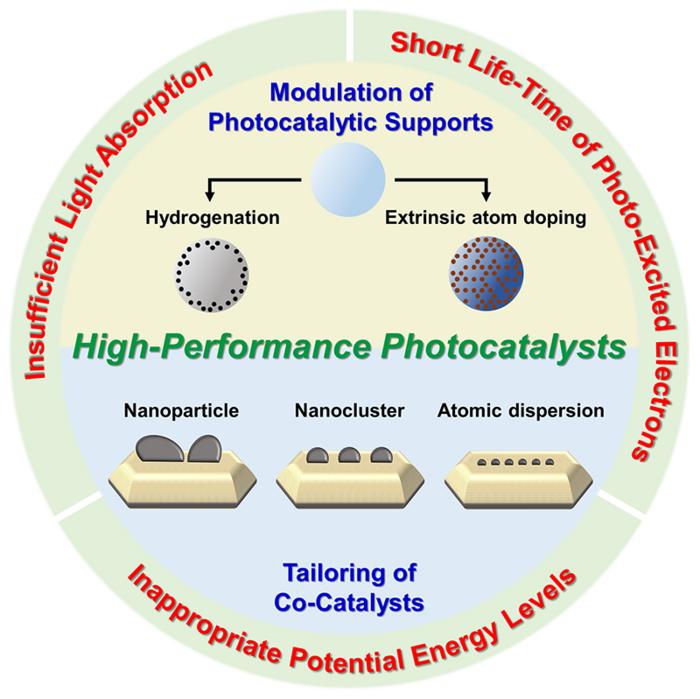A new frontier in clean energy has been unveiled by a research team dedicated to synthesizing high-performance photocatalysts tailored for solar-driven hydrogen production and carbon dioxide reduction. Published in the esteemed journal Carbon Future, this review paper sheds light on the innovative strategies being explored to enhance the efficiency of photocatalysis, a promising technology that harnesses solar energy for sustainable applications. As the globe grapples with climate change, the significance of this research extends beyond academic interest, offering potential solutions to urgent environmental crises.
Photocatalysis operates on the principle of utilizing light to accelerate chemical reactions, a mechanism that could revolutionize our approach to energy generation. Underpinning this technology is the ability to convert benign substrates into fuel while minimizing harmful emissions. However, photocatalysis has faced challenges that have hindered its broader adoption, particularly its relatively low catalytic efficiency compared to other energy conversion methods. Researchers are intensely focused on overcoming these limitations through innovative synthetic designs.
The review specifically evaluates the development of photocatalytic supports and co-catalysts, which constitute the core components of efficient photocatalytic systems. By refining these components, researchers aim to enhance light absorption and extend the lifetime of generated charge carriers. This not only improves the overall efficiency of the photocatalytic process but also supports the generation of renewable energy in a manner that aligns with sustainability goals. Techniques such as hydrogenation and extrinsic doping provide promising avenues for achieving these improvements.
The synthesis of efficient photocatalysts is not a straightforward task, necessitating a blend of chemical ingenuity and strategic planning. The research team outlines practical case studies detailing how these advanced synthetic approaches can be effectively utilized to produce photocatalysts for clean energy applications. The ability of these materials to engage in complex chemical reactions plays a pivotal role in the transition to sustainable energy systems, shaping the future of energy production.
In their meticulous exploration, the researchers underscore the need for innovative co-catalyst designs. These designs must focus on optimizing the electronic properties of charge carriers, allowing for better utilization and energy conversion. As co-catalysts have a direct influence on the kinetics of photocatalytic reactions, their careful engineering becomes paramount in producing systems capable of withstanding rigorous operational conditions while maintaining high efficiency.
The progression towards effective photocatalytic systems is further complicated by the existing competitive energy conversion technologies, such as electrocatalysis and thermocatalysis. While these methods have well-established efficiencies, the gap in performance with photocatalysis highlights a critical area for investigation and development. It emphasizes the urgency of refining photocatalytic systems so they can compete on a larger scale, achieving efficiencies that would make them feasible for widespread implementation.
To facilitate this, an integrated approach combining novel photocatalytic support modulation and co-catalyst optimization has shown promise. Researchers suggest that employing two distinct metal atoms as co-catalysts could unlock new catalytic pathways, presenting a rich area for exploration that could significantly elevate photocatalytic performance. This perspective encourages a departure from traditional single-metal catalyst systems towards more complex architectures that leverage multifaceted interactions.
Despite the advancements made in photocatalytic processes, achieving a standardized system suitable for industrial application remains elusive. The research introduces the concept of floatable photocatalytic reaction platforms, signaling a shift from traditional fixed setups. These platforms hold the potential for scalable reactions that could be implemented in various commercial processes. The push for developing innovative and efficient reaction platforms aligns with the greater aim of establishing photocatalysis as a mainstream renewable energy technology.
Additionally, the research hints at the untapped potential of biomass in photocatalytic processes. Lignocellulose, being abundantly available, could serve as a valuable feedstock for producing hydrogen gas through photocatalytic methods. Bridging the gap between different catalytic technologies could yield high-performance photocatalysts capable of generating a wide range of vital industrial chemicals, paving the way for a circular economy that minimizes waste and maximizes resource utilization.
As the research community continues to articulate the merits of photocatalytic strategies, the necessity for collaborative efforts becomes apparent. Engaging in interdisciplinary research that combines insights from various fields of study is crucial for overcoming the complexities associated with photocatalysis. The synergy between fundamental research and practical implications could catalyze breakthroughs that propel photocatalysis into the limelight of clean energy technologies.
The momentum generated by this research is amplified by a collective commitment to sustainable development and environmental stewardship. As scientists unite to address the pressing challenges brought about by climate change, strategies for developing high-performance photocatalysts will undoubtedly remain at the forefront of this initiative. With their ability to harness solar energy and minimize hydrocarbon emissions, photocatalysts represent a vital component in our quest for cleaner energy solutions.
In conclusion, the era of relying on conventional energy sources is gradually coming to a close. The future of energy production lies in clean, renewable technologies like photocatalysis, which promise to reshape our energy landscape. With further advancements and consistent investments in research, the development of high-performance photocatalysts will play a quintessential role in achieving global sustainability objectives, transforming not just the energy sector, but also the way societies interact with their environment.
Subject of Research: Photocatalytic performance enhancement through synthetic design
Article Title: Synthesis of high-performance photocatalysts for solar-driven hydrogen production and carbon dioxide reduction
News Publication Date: December 24, 2024
Web References: https://doi.org/10.26599/CF.2024.9200025
References: N/A
Image Credits: Carbon Future, Tsinghua University Press
Keywords
Photocatalysis, Renewable Energy, Hydrogen Production, Carbon Dioxide Reduction, Sustainability, Clean Energy Technologies





